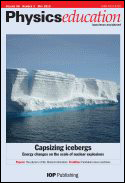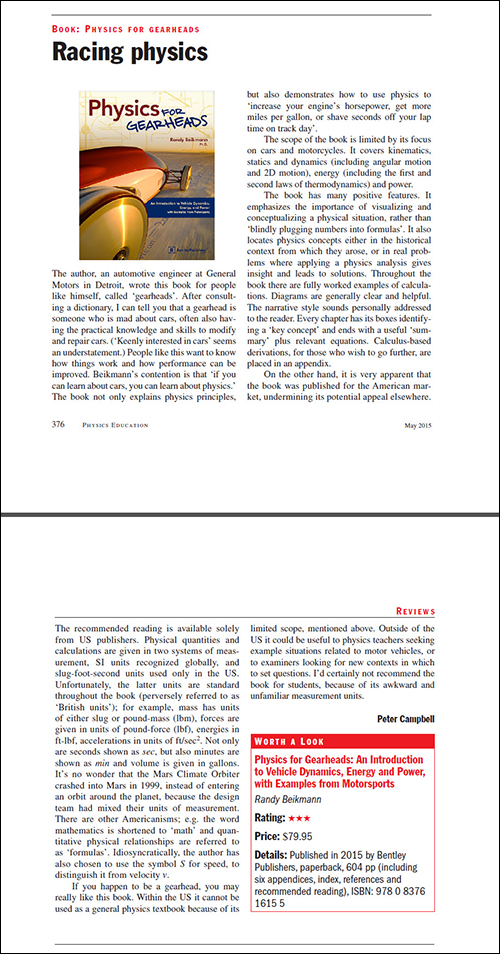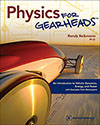|
Now Available! |
Physics for Gearheads
Price: $119.95
|

Physics Education - May 2015
Racing Physics
The author, an automotive engineer at General Motors in Detroit, wrote this book for people like himself, called 'gearheads'. After consulting a dictionary, I can tell you that a gearhead is someone who is mad about cars, often also having the practical knowledge and skills to modify and repair cars. ('Keenly interested in cars' seems an understatement.) People like this want to know how things work and how performance can be improved. Beikmann's contention is that 'if you can learn about cars, you can learn about physics.' The book not only explains physics principles, but also demonstrates how to use physics to 'increase your engine's horsepower, get more miles per gallon, or shave seconds off your lap time on track day'.
The scope of the book is limited by its focus on cars and motorcycles. It covers kinematics, statics and dynamics (including angular motion and 2D motion), energy (including the first and second laws of thermodynamics) and power.
The book has many positive features. It emphasizes the importance of visualizing and conceptualizing a physical situation, rather than 'blindly plugging numbers into formulas'. It also locates physics concepts either in the historical context from which they arose, or in real problems where applying a physics analysis gives insight and leads to solutions. Throughout the book there are fully worked examples of calculations. Diagrams are generally clear and helpful. The narrative style sounds personally addressed to the reader. Every chapter has its boxes identifying a 'key concept' and ends with a useful 'summary' plus relevant equations. Calculus-based derivations, for those who wish to go further, are placed in an appendix.
On the other hand, it is very apparent that the book was published for the American market, undermining its potential appeal elsewhere. The recommended reading is available solely from US publishers. Physical quantities and calculations are given in two systems of measurement, SI units recognized globally, and slug-foot-second units used only in the US. Unfortunately, the latter units are standard throughout the book (perversely referred to as 'British units'); for example, mass has units of either slug or pound-mass (lbm), forces are given in units of pound-force (lbf), energies in ft-lbf, accelerations in units of ft/sec2. Not only are seconds shown as sec, but also minutes are shown as min and volume is given in gallons. It's no wonder that the Mars Climate Orbiter crashed into Mars in 1999, instead of entering an orbit around the planet, because the design team had mixed their units of measurement. There are other Americanisms; e.g. the word mathematics is shortened to 'math' and quantitative physical relationships are referred to as 'formulas'. Idiosyncratically, the author has also chosen to use the symbol S for speed, to distinguish it from velocity v.
If you happen to be a gearhead, you may really like this book. Within the US it cannot be used as a general physics textbook because of its limited scope, mentioned above. Outside of the US it could be useful to physics teachers seeking example situations related to motor vehicles, or to examiners looking for new contexts in which to set questions. I'd certainly not recommend the book for students, because of its awkward and unfamiliar measurement units.

Review from and courtesy of Physics Education - May 2015
http://iopscience.iop.org/0031-9120/50/3/372/pdf/0031-9120_50_3_372.pdf
![[B] Bentley Publishers](http://assets1.bentleypublishers.com/images/bentley-logos/bp-banner-234x60-bookblue.jpg)
